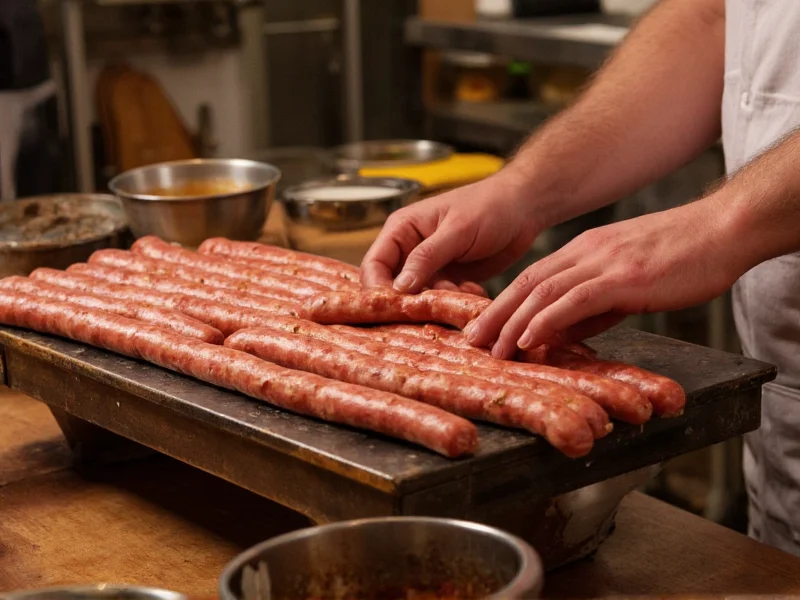Understanding Modern Sausage Manufacturing Facilities
When people search for the sausage factory, they're often curious about what happens behind the scenes of meat processing. Contrary to popular misconceptions, today's sausage production facilities operate under rigorous food safety standards with transparent processes that prioritize both quality and consumer health.
Historical Evolution of Sausage Production
The term sausage factory historically carried negative connotations due to Upton Sinclair's 1906 novel The Jungle, which exposed unsanitary conditions in early 20th century meatpacking plants. This groundbreaking work led to the creation of the Pure Food and Drug Act and the Meat Inspection Act of 1906.
Modern sausage manufacturing has evolved dramatically since those early days. Today's facilities incorporate advanced food science, automated processing equipment, and comprehensive quality control systems that would be unrecognizable to Sinclair's contemporaries.
The Contemporary Sausage Production Process
Understanding how sausage factories operate today requires examining the step-by-step transformation from raw ingredients to finished product:
- Ingredient selection and preparation - High-quality meat (typically pork, beef, or poultry), fat, seasonings, and curing agents are carefully measured according to specific recipes
- Grinding and emulsification - Meat and fat pass through industrial grinders at controlled temperatures to achieve the proper texture
- Mixing and seasoning - Precise amounts of spices, salt, nitrites (for preservation), and other ingredients are incorporated uniformly
- Stuffing - The sausage mixture is pumped into natural casings (animal intestines) or synthetic casings using automated stuffing machines
- Linking and twisting - For linked sausages, automated systems create uniform portions by twisting the casings
- Cooking or smoking - Depending on the product type, sausages undergo precise temperature-controlled cooking, smoking, or fermentation processes
- Chilling and packaging - Finished products are rapidly cooled and packaged using modified atmosphere techniques to extend shelf life
| Process Stage | Temperature Control | Duration | Quality Checks |
|---|---|---|---|
| Grinding | 0-4°C (32-39°F) | 15-30 minutes | Particle size verification |
| Mixing | 4-7°C (39-45°F) | 10-20 minutes | Emulsion stability testing |
| Cooking | 68-74°C (155-165°F) | 20-45 minutes | Internal temperature monitoring |
| Chilling | 1-4°C (34-39°F) | 2-4 hours | Microbial testing |
Food Safety and Quality Assurance Systems
Modern sausage manufacturing facilities implement multiple layers of food safety protocols:
- HACCP (Hazard Analysis Critical Control Point) systems identify potential hazards at each production stage
- Pathogen testing occurs regularly for salmonella, listeria, and E. coli
- Traceability systems allow complete tracking from raw materials to finished products
- Third-party audits verify compliance with food safety standards
- Environmental monitoring ensures facility cleanliness between production runs
These measures have transformed the modern sausage factory from the hazardous environments described in historical accounts to highly regulated food production facilities that prioritize consumer safety above all else.
Debunking Common Sausage Production Myths
Several persistent myths surround sausage manufacturing that deserve clarification:
- Myth: Sausages contain mysterious "mystery meat" or undesirable parts
Reality: Regulations require clear labeling of ingredients, and most commercial sausages use specific cuts of meat - Myth: All sausages contain harmful levels of preservatives
Reality: Nitrites serve important food safety functions by preventing botulism, and their usage is strictly regulated - Myth: Modern sausage factories use the same unsanitary practices as early 1900s facilities
Reality: Today's facilities undergo regular government inspections and implement advanced sanitation protocols
The Future of Sausage Manufacturing
Emerging trends in contemporary sausage production include:
- Increased transparency through facility tours and video documentation
- Development of cleaner label products with fewer additives
- Expansion of specialty sausages catering to dietary preferences (gluten-free, organic, heritage breed)
- Implementation of more sustainable packaging solutions
- Integration of precision fermentation for plant-based sausage alternatives
These innovations demonstrate how the sausage factory of today continues evolving to meet changing consumer expectations while maintaining the culinary traditions that have made sausages a global food staple for centuries.
Frequently Asked Questions
What happens inside a modern sausage factory?
Modern sausage factories transform raw meat and ingredients through controlled processes including grinding, mixing with seasonings, stuffing into casings, cooking or smoking, and packaging. These facilities operate under strict food safety regulations with multiple quality control checkpoints throughout production.
Are sausage factories safe for food production today?
Yes, contemporary sausage manufacturing facilities follow rigorous food safety protocols including HACCP systems, regular pathogen testing, environmental monitoring, and third-party audits. Modern regulations and oversight ensure that sausage production meets high safety standards that have evolved significantly since early 20th century practices.
What ingredients are actually used in commercial sausage production?
Commercial sausages typically contain specific cuts of meat (pork, beef, or poultry), fat, salt, seasonings, and sometimes curing agents like nitrites. Regulations require clear ingredient labeling, and reputable manufacturers use traceable sources for all components. The notion of "mystery meat" in modern commercial sausages is largely a myth.
How has sausage production changed since Upton Sinclair's The Jungle?
Sausage production has transformed dramatically since the early 1900s. Modern facilities feature stainless steel equipment, temperature-controlled environments, automated processes, comprehensive sanitation protocols, and rigorous food safety testing. The Pure Food and Drug Act and Meat Inspection Act of 1906 initiated these changes, which have continued evolving with advances in food science and technology.











 浙公网安备
33010002000092号
浙公网安备
33010002000092号 浙B2-20120091-4
浙B2-20120091-4